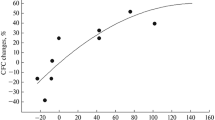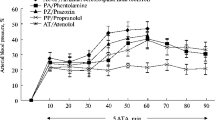The experiments employing high-frequency ultrasonic technique and selective blockers of M1, M3, and M4 muscarinic cholinergic receptors pirenzepine, 4-DAMP, and tropicamide, respectively, revealed individual roles of these receptors in the development of severe posthemorrhagic hypotension in rats with low or high individual resistance to circulatory hypoxia. The study showed that M1 and M4 muscarinic receptors are involved in shock-limiting and shock-activating processes, respectively, while M3 receptors exert no effect on the course of posthemorrhagic abnormalities in systemic and hepatic portal circulation and on the posthemorrhagic lifespan. Poor resistance of the cardiovascular system to circulatory hypoxia during shock development is considered to be dysregulatory pathology.
Similar content being viewed by others
References
N. Ya. Kovalenko and D. D. Matsievskii, Patogenez, No. 2, 53–66 (2004).
N. Ya. Kovalenko and D. D. Matsievskii, Byull. Eksp. Biol. Med., 140, No. 8, 142–145 (2005).
A. B. Kosmachev, V. A. Belyaev, A. V. Khrabrova, et al., Eksp. Klin. Farmakol., 61, No. 5, 3–5 (1998).
G. N. Kryzhanovsky, Dysregulatory Pathology [in Russian], Moscow (2002).
D. D. Matsievskii, Byull. Eksp. Biol. Med., 138, No. 10, 612–616 (2004).
D. D. Matsievskii, Byull. Eksp. Biol. Med., 136, No. 7, 115–118 (2003).
N. P. Podosinovikova, L. F. Gorobets, and V. B. Dolgo-Saburov, Byull. Eksp. Biol. Med., 122, No. 7, 75–77 (1996).
K. J. Broadly and D. B. Kelly, Molecular, No. 6, 142–193 (2001).
R. M. Eglen and R. L. Whiting, J. Auton. Pharmacol., 10, No. 4, 233–245 (1990).
V. A. Pujol Lereis, F. J. Hita, M. D. Gobbi, et al., Br. J. Pharmacol., 147, No. 5, 516–523 (2006).
H. Shi, H. Wang, and Z. Wang, Mol. Pharmacol., 55, No. 3, 497–507 (1999).
L. Walch, C. Brink, and X. Norel, Therapie, 56, No. 3, 223–226 (2001).
Author information
Authors and Affiliations
Corresponding author
Additional information
Translated from Byulleten’ Eksperimental’noi Biologii i Meditsiny, Vol. 152, No. 9, pp. 260-264, September, 2011
Rights and permissions
About this article
Cite this article
Kovalenko, N.Y., Matsievskii, D.D. & Reshetnyak, V.K. Role of Various Subtypes of Muscarinic Cholinergic Receptors in the Development of Posthemorrhagic Abnormalities in Systemic and Portal Circulation in Rats. Bull Exp Biol Med 152, 293–297 (2012). https://doi.org/10.1007/s10517-012-1511-4
Received:
Published:
Issue Date:
DOI: https://doi.org/10.1007/s10517-012-1511-4




